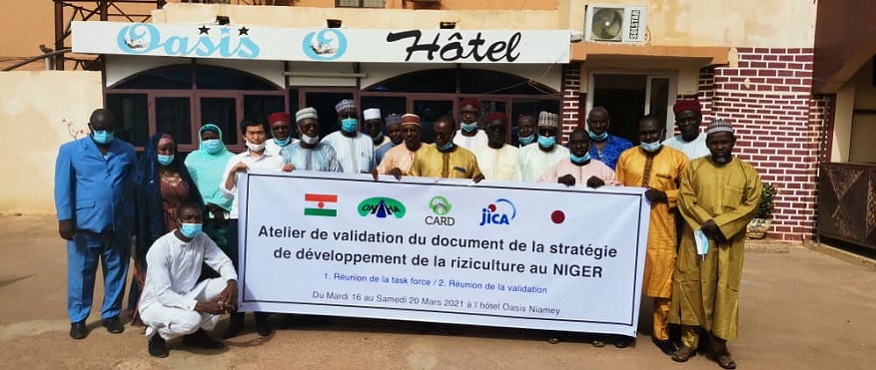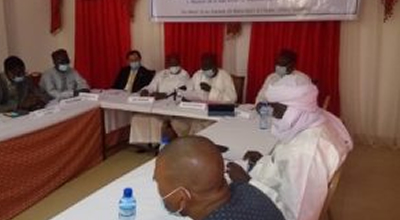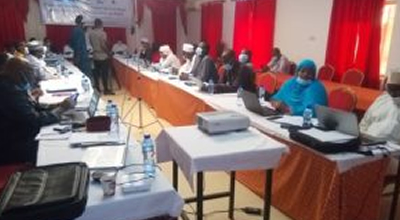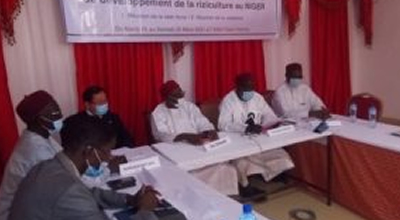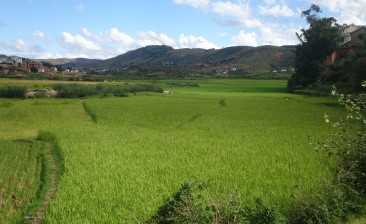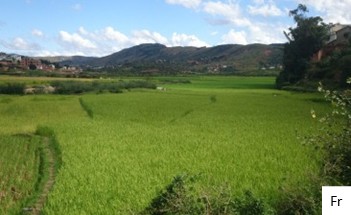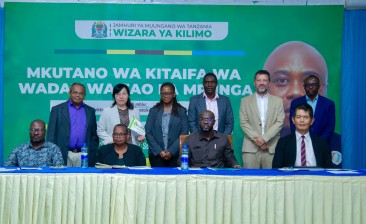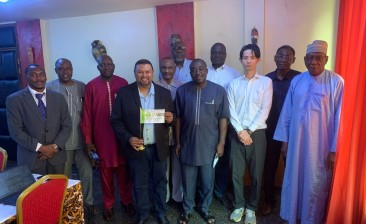Niger, March 2021
NRDS II finalization and validation working week in Niger
To overcome the shortcomings in rice production and tackle the consequences of the food price crisis of 2008, the Government of Niger in collaboration with development partners and the main actors of the rice sector has put in place bold measures through NRDS I to promote the rice sector. As a result, the domestic rice production increased from about 86,000 tons in 2008 to 115,585 tons in 2018, at an average annual growth of 3.1 % due both to a slight increase in areas and yields during the last four years. However, despite this growth, local production only covers one-sixth (1/6) of annual national needs, estimated at 435,150 tons of rice and only 27% of the target set under the NRDS I.
Conscious of this situation and the existing strengths in the rice sector, the Government, with the support of the CARD, has decided to develop a new rice development strategy (NRDS II), taking into account the lessons learned from the implementation of the NRDS I.
This is the context in which this NRDS II finalization and validation workshop took place from March 16 to 20, 2021. Niger’s NRDS II was finalized through three phases. The first phase of finalization of the NRDS II (from 16/03/2021 to 18/03/2021), the second phase of validation of the NRDS II (19/03/2021), and the third phase of integration of observations from the validation workshop (20/03/2021). The first and third phases saw the participation of all members of the Rice Task Force, and the second phase saw the participation of all actors active in the rice sector.
Key results
A new National Rice Development Strategy (NRDS II) was developed with the general objective of “contributing in the medium term to a sustainable increase in national rice production in quantity and quality in order to meet long-term needs and export to regional and in international markets”.
The specific objectives of the new NRDS II are: (i) to increase rice production and productivity; (ii) to promote the processing, marketing, and competitiveness of local rice; and (iii) to improve the institutional environment and the technical and organizational capacities of the actors.
The quantitative objectives of the strategy are to:
- increase the paddy production from 127,861 tons in 2021 to 1,458,059 tons by 2030;
- increase the average yield of irrigated rice from 5.8 t/ha in 2021 to 8.4 t/ha by 2030; increase the average yield of rainfed rice cultivation from 1.5 t/ha in 2021 to 4.5 t/ha by 2030;
- develop at least 82,507 ha of irrigation schemes by 2030;
- produce rainfed rice over an area of 170,000 ha by 2030;
- increase the rate of use of certified seed to 100% in irrigated production areas and to 40% in rainfed production areas;
- increase the rate of mechanization to 100% in irrigated production areas and at least 30% in rainfed production areas by 2030;
- strengthen processing capacities so that 85% of the paddy produced is processed according to technical standards, by 2030;
- increase the number of industrial processing units from 7 in 2021 to 302 by 2030 and the number of artisanal processing units from 135 in 2021 to 402 by 2030;
- increase the extension agent rate to at least one agent for every 60 ha by 2030;
- Recruit 348 new extension agents to cover the personnel needs of all players in the sector.
The achievement of the objectives will be done in two (2) phases.
- The first phase, 2021-2025: It consists of consolidating the achievements of previous rice policies and implementing measures to enable the country to achieve self-sufficiency in 2025. Concretely, the increase in production will be achieved through support for cultivating rice efficiently over an area of 198,507ha (41% irrigated and 59% rainfed). This support will include the provision of 10,016 tons of improved seeds, 40,065 tons of urea, 40,065 tons of NPK, 1.05 tons of herbicides, 16.82 tons of fungicides, and 992,535 tons of organic fertilizer. The objective is to cover market demand for rice by 2025, through local production of 575,936 tons of white rice against an estimated 569,611 tons, i.e., a surplus of 6,326 tons.
- The second phase, 2026-2030: It aims to produce rice on more than 252,507 ha (33% irrigated and 67% rainfed). To do this, in addition to the actions of the first phase, it will be necessary to provide the following quantities of inputs: 1,750 tons of improved seeds, 7,000 tons of urea, and 7,000 tons of NPK, 0.7 tons of fungicide, and 2 tons of herbicide. Rice production will reach nearly 1,458,059 tons of paddy in 2030, or 947,738 tons of white rice against an estimated need of 689,693 tons. This corresponds to an additional production surplus of 258,045 tons of white rice.
The cost of the strategy is estimated at 426.3 billion FCFA, including 283.5 billion for the first phase (2021-2025) and 142.8 billion for the second phase (2026-2030). Since the investments required are enormous, the financing strategy will revolve around the mobilization of internal and external resources. As such, the funds will be requested from the national budget, Public-Private Partnership (PPP), donors through projects/programs, and contributions from beneficiaries.
In order to proceed with the endorsement of the Strategy by the Government, the document will be submitted for examination and validation during the first 100 days of the new President. Following this, a working week will be organized for the preparation of concept notes and lobbying for the required financial resources for NRDS II implementation.
